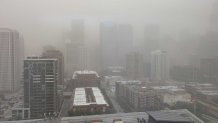Dust Storm Hits Chicago Area
A large dust storm swept through the Chicago area Friday, coming on the heels of a night of severe thunderstorms Thursday that left over 100,000 people without power.
Temperatures remained very warm on Friday, with gusty winds impacting the region throughout the day amid a threat of severe thunderstorms and fire-conducive conditions.
Weather Conditions
The strong winds throughout the day, with localized gusts reaching 50 to 60 miles per hour, contributed to the issuing of a Red Flag Warning, particularly impacting regions that weren’t hit by rainfall on Thursday.
While large-scale brush fires never materialized Friday, the dry conditions in areas not impacted by Thursday’s rainfall combined with the dangerous region-wide winds to create a blowing dust threat.
Historic Event
Though dust storms have impacted Illinois expressways before, Friday’s event marked a moment of history for the city of Chicago.
Well that was…..something.
This marks the second Dust Storm Warning in our office’s history. The first was on May 7, 2023. However, that warning was away from the metro area. This was the first Dust Storm Warning that included the city of Chicago.
— NWS Chicago (@NWSChicago) May 17, 2025
Impact on the City
The dust storm created eerie sights throughout the city of Chicago, showing a normally majestic skyline nearly completely covered by the blowing dust.

Causes of Dust Storms
Though dust storms aren’t particularly common in Illinois, the late spring is when they typically occur, with high winds blowing topsoil from recently tilled fields across large distances.
Much of the state’s topography is also favorable for the storms, due to large swaths of flat land with few trees and plants, which allow winds to build up momentum at a quicker pace.
Effects of Dust Storms
In addition to causing decreased visibility that creates life-threatening travel conditions, the storms have the potential to affect air quality in the region for days afterwards.
Air quality readings across the region on Friday evening were above 100 AQI in some areas, designated as “unhealthy for sensitive groups.”
Conclusion
The dust storm that hit the Chicago area on Friday was a significant event, marking the first time a Dust Storm Warning was issued for the city. The storm caused decreased visibility, affected air quality, and created life-threatening travel conditions. It is essential for residents to be aware of the causes and effects of dust storms and take necessary precautions to stay safe.
Frequently Asked Questions
Q: What is a dust storm?
A: A dust storm is a type of storm that occurs when strong winds blow topsoil from dry areas, reducing visibility and affecting air quality.
Q: What are the causes of dust storms?
A: Dust storms are typically caused by a combination of strong winds, dry conditions, and the presence of loose topsoil.
Q: What are the effects of dust storms?
A: Dust storms can cause decreased visibility, affect air quality, and create life-threatening travel conditions.
Q: How can I stay safe during a dust storm?
A: To stay safe during a dust storm, it is essential to stay indoors, avoid traveling, and keep windows and doors closed to prevent dust from entering your home.
Q: What is the difference between a dust storm and a sandstorm?
A: A dust storm and a sandstorm are similar, but a dust storm typically occurs in areas with dry topsoil, while a sandstorm occurs in areas with loose sand.


